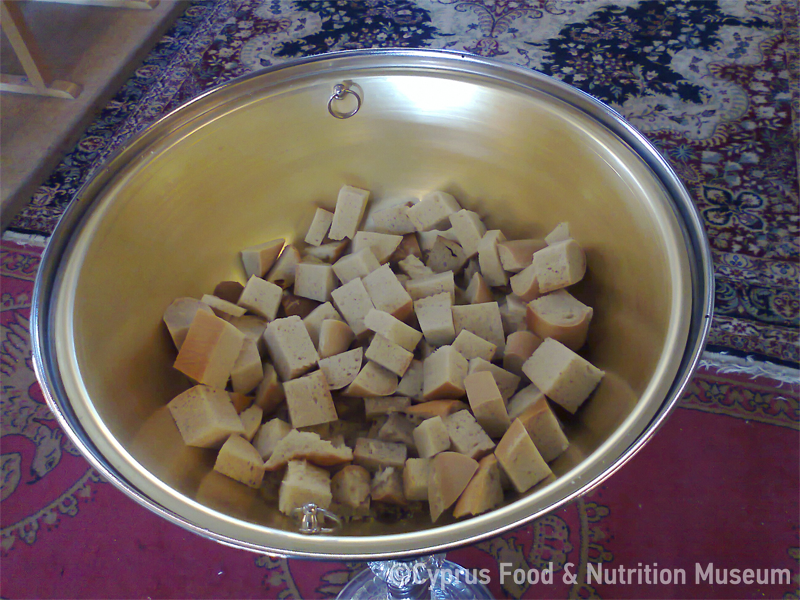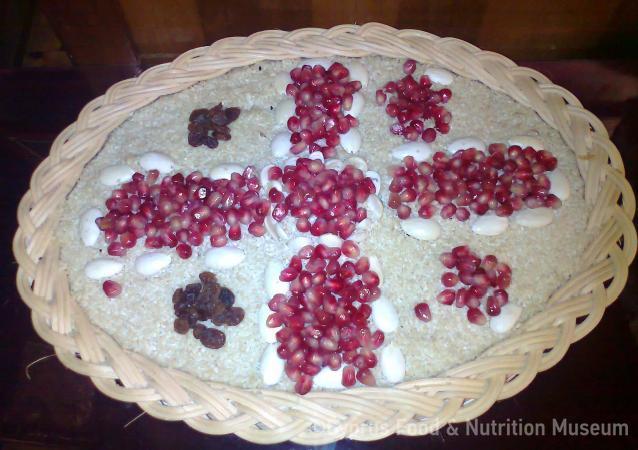Name - Origin
It is a sesame bread offered by Christians to the church during feasts (Yangoullis 2009, entry παννυσ̆ί(δ)ες - παννυχί(δ)ες,οι, 338), together with kollyva. Sesame bread, prepared at Christmas was also called Pannys̆ida in Cyprus; they are known as hristopsoma in Greece (Kypri 1983 [2003²], entry παννυσ̆ίδα,η, 331). Eugenia Petrou-Poeitou notes that it is a large bread with sesame seeds and embossed decorations, which is usually made for memorial services (Petrou-Poeitou 2013, entry Πανυσήια, Παννυχίδα, 108).
Georgios Loukas states that it is bread placed in kollyva during feasts or memorial services (Kypri 1979 [2002²], entry παννυχίδα, 357).
ETYM. < medieval παννύχιος (pannyhios) < ancient pannyhis (Yangoullis 2009, entry παννυσ̆ί(δ)ες - παννυχί(δ)ες,οι, 338) According to Xenophon P. Pharmakidis, it is derived from the words πᾶξ-νύξ (pax-nyx), παννύχιος (pannyhios), like the Homeric «εὗδον παννύχιοι» (eudon pannyhio) or the ecclesiastical «παννύχιον ἡμῖν τήν σήν δοξολογίαν χάρισαι εἰς τό ὑμνεῖν».
It means an overnight prayer to God, which was performed during the first centuries of Christianity. Afterwards, the overnight prayers (pannyhides) were replaced by the vespers, so, in remembrance, the bread offered during the pannyhides (prayers) has been named pannys̆i(d)a (Kypri 1983 [2003²], entry παννυσ̆ίδα,η, 331). Ioannis Erotokritos, in his Glossary, notes that pannis̆ía is the all-night prayer and metaphorically, bread, which is offered at the all-night prayers (Kypri 1989, entry παννυσ̆ία,η, 148). Petrou-Poeitou mentions the same, and so does Loukas in his Glossary: this particular bread owes its name to the pannyhida of the early Christians, which they used to eat during their overnight prayers (Petrou-Poeitou 2013, entry Πανυσήια, Παννυχίδα, 108; Kypri 1979 [2002²], entry παννυχίδα, 357). As per Erotokritos, the Cypriots never use the word in its primary meaning, but always name the bread, which is offered in the church (Kypri 1989, entry παννυσ̆ία,η, 148).
They are made from semolina or fine flour with great care; unlike ordinary bread, the dough is kneaded as long as necessary to become firm and to gain some heat from the friction. After they are baked, they are not soft like ordinary bread, but they are somewhat hard (Kypri 1983 [2003²], entry παννυσ̆ίδα,η, 331).
Functional and symbolic role
The bread was offered in the church during the various Christian feast days. It was also baked at Christmas (Kypri 1983 [2003²], entry παννυσ̆ίδα,η, 331).
Erotokritos distinguishes between three types of bread. Referring to the second type, he points out that the five loaves offered to the church symbolise the five loaves that Jesus Christ had blessed (Kypri 1989, entry παννυσ̆ία,η,148).
Additional information and bibliography
Erotokritos mentions that there are three types of bread:
α) Ártos is shaped like ordinary bread and sprinkled with sesame seeds, melanthios [nigella seeds], aniseed and other herbs/ spices. The wife of a person who is celebrating, sends this type of bread to her friends and relatives on the eve of the feast, together with a plate of kollyva.
(b) Prósphoro is a type of bread that is shaped differently from the ordinary bread. It is wider and has a smooth and shiny surface; five loaves of this type are offered to the church.
c) Pannis̆í(d)a, is similar in shape to prosphoro but it is much larger and sprinkled with sesame seeds, melanthio (nigella seeds), aniseed, etc. Two loaves are placed over canisters with kollyva at vespers and two of them during mass. Usually, after the service, two of these are cut in pieces and offered to the congregation in the churchyard (Kypri 1989, entry παννυσ̆ία,η, 148).
Great attention is given to decoration, which provides fine examples of folklore art, in a variety of traditional motifs. Christian symbols, having the cross as a key element, geometric shapes and various themes from nature are masterfully combined together and impress with their symmetry, simplicity and careful presentation. Housewives would always compete on presenting the most neat ártos and the most beautifully decorated pitta. In some regions, they usually knead two pittes or pannys̆ides, in order to take a small one at vespers and a large one on the day of the feast. The decoration of the large pannys̆ida was rich and imaginative, and was so carefully and skilfully done that, in many cases, it looks like real embroidery. A cross, daisies, grapes, leaves of various kinds, thorns etc., all these are made of dough, decorating the top of the bread. There is a great number of customs and various perceptions surrounding the preparation of this type of bread, revealing how sacred it is in people's consciousness (Kypri and Protopapa 2007, 265-6).
Yangoullis K. G. (2009), Θησαυρός Κυπριακής Διαλέκτου. Ερμηνευτικό, Ετυμολογικό, Φρασεολογικό και Ονοματολογικό Λεξικό της Μεσαιωνικής και Νεότερης Κυπριακής Διαλέκτου, Βιβλιοθήκη Κυπρίων Λαϊκών Ποιητών, Theopress Publications, Nicosia.
Kypri Th. D. (ed.) (1979 [2002²]), Υλικά διά την σύνταξιν ιστορικού λεξικού της κυπριακής διαλέκτου, Μέρος Α΄, Γλωσσάριον Γεωργίου Λουκά, Publications of the Centre for Scientific Research, XLI, Nicosia.
Kypri Th. D. (ed.) (1983 [2003²]), Υλικά διά την σύνταξιν ιστορικού λεξικού της κυπριακής διαλέκτου, Μέρος Β΄, Γλωσσάριον Ξενοφώντος Π. Φαρμακίδου, Publications of the Centre for Scientific Research, IX, Nicosia.
Kypri Th. D. (ed.) (1989), Υλικά διά την σύνταξιν ιστορικού λεξικού της κυπριακής διαλέκτου, Μέρος Γ΄, Γλωσσάριον Ιωάννου Ερωτοκρίτου, Publications of the Centre for Scientific Research, XIV, Nicosia.
Kypri Th. and Protopapa K. (2007), 'Κυπριακά παραδοσιακά ζυμώματα', στο Φούρνοι και παραδοσιακά ζυμώματα στη Θράκη, το Αιγαίο και την Κύπρο(Thrace-Aegean-Cyprus Programme), Thira, 261-278.
Petrou-Poeitou E. (2013), Από πού κρατάει η σκούφια τους. Λέξεις και ιστορίες από τον κόσμο της γεύσης, Epiphaniou Publications, Nicosia.
Stalo Lazarou, Argyro Xenophontos, Tonia Ioakim


